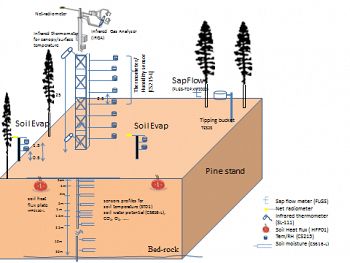Sensors & Field Instruments
An instrumented tower will estimate whole ecosystem fluxes of energy, water, and carbon, and will be accompanied by a system of belowground sensors in an "inverted tower". Application for construction permitting is being filed with the USFS Enoree District.
Tower schematic. The first 30' tall flux tower was installed in a young pine stand at the Calhoun CZO in August, 2016.
Precipitation and Streamflow
Rainfall intensity will be recorded with multiple rainfall gauges. In concert with rainfall intensity, stream flow measurements will be used to evaluate catchment hydrologic response and quantify how on-going responses have changed over the last 50 years. Precipitation and streamflows from the three experimental catchments will be sampled with wet-dry collectors and by grab and automated stream sampling for analysis of macro-ion chemistry and various isotopic studies.
Vegetation
Aboveground vegetation on 32 0.1-ha plots was measured in the summer of 2014, including tree diameter and height, and canopy light interception with a Licor LAI-2000. These data will be combined with vegetation data obtained from a LiDAR flight that was flown by NCALM in late July and early August 2014.
Belowground Sensor-Sampler Installations
Co-located sensors and samplers will be installed at different belowground depths on interfluve, mid-hillslope, footslope, and floodplain locations in the experimental catchments, and in reference hardwood and paired old-field forests. Sensors will include moisture, water potential, temperature, CO2, O2, and redox potential, and data will be logged with loggers and downloaded periodically or by remote access. At each depth, sensors will be co-located within a few meters in horizontal distance with a soil gas reservoir of our own design, and soil-water samplers. Gas and water samplers will be collected periodically and analyzed for gas concentrations of O2, CH4, 222Rn, and CO2, and water concentrations of cations and anions.
Flux tower
An eddy-flux tower is to be installed on a broad interfluve. The site will have been monitored for two years with co-located belowground sensors and samplers. Eddy-covariance towers will be installed on an old field interfluve immediately after a clearcut. Eddy-flux towers will be instrumented with 3-D sonic anemometers, infrared gas analyzers for CO2 and H2O, net radiation sensors, rain gages, as well as low-frequency air temperature and humidity sensors, and soil heat flux plates. Update: the first flux tower was installed in August 2016 - see news story for more details.
Water Chemistry and Stream Discharge
In addition to stream water chemistry collected by auto-samplers, we also analyze intermittent spring and seep chemistry, groundwater, precipitation and soil pore chemistry. We measure a wide range of parameters including pH, conductivity, alkalinity, multiple cations and anions, and 18O. There are multiple stream discharge gauges, some nested, at the CCZO.
Explore Further

